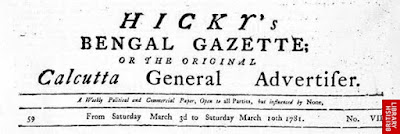Mohammad Arsalan
________________
While looking back to the history
and advent of the press in India, one would realise the pivotal role newspapers
have played in bringing social reforms as well as in the freedom struggle of
the country. It goes way back in 1780 when James
Augustus Hickey started the
first Indian newspaper in Calcutta (now Kolkata) known as Bengal Gazette. Further social
reformers and freedom fighters like Raja
Ram Mohan Roy, Annie Basant, Bal Gangadhar Tilak, M. K. Gandhi, Sir Syed Ahmad
Khan, J. A. Nehru, Shukat Ali, Maulana Abul Kalam Azad and so on started different newspapers
that possessed contents paving avenues for freedom and social reform. Many
philosophies and debates on freedom of press also have the history from its
origin. As the newspapers were becoming influential in decoding policies and
the hegemony of the then British government many laws were passed to gag the
press like Vernacular Press Act 1878 under the Viceroy ship of Lord Lytton and
Gagging Act by Lord Canning.
James Hickey also known as father of journalism in India
wrote fearlessly against the Government policies and mainly targeted the then
Governor General of India – Warren
Hastings. He used words like “The
Great Moghul” and “Dictator” to describe him. He tried to expose
the hidden agendas of British East India Company. In repercussion of his blunt
writings he was also put behind bars for more than two years. A great
educationist and founder of Aligarh Muslim University Sir Syed Ahmad Khan
started two journals Tehzib-ul-Akhlaq and Aligarh
Institute Gazette. Philanthropist Raja
Ram Mohan Roy started first
nationalist newspaper in India. Roy started Brahmanical
Magazine in 1819, Brahmin Sebodhi in 1819 – a bilingual periodical, Sambad Kamudi in 1821, in the same year he also
started Mirat-ul-Akhbar: a
Persian newspaper. Roy was a great statesman who brought dramatic social reform
in Hindu society. He abolished the draconian Sati
Pratha, Roy was against the orthodoxies prevailing in the Indian societies,
he firmly stood against cast system, idol-worship and challenged other social
dogmas. In that era, local newspapers in Indian languages were also started
like Dig Darshan in 1818 (Bengali monthly), Samachar Darpan in 1819 (Bengali weekly) and so on.
The revolt of 1857 can be seen as a vital phase in the British India as it
marked a drift in Indian media. In 1857 a Hindi-Urdu publication Payam-e-Azadi was started that urged people across
the country to fight against the British. Revolutionaries felt the extensive
need to vocal their struggle and reach to the masses. For that matter a lot
many newspapers were started after 1857 and many of them still exist today like Times of India started in 1861, Amrit Bazar Patrika in 1865, Madras Mail in 1868, The Statesman in 1875, The Pioneer in 1865, The Hindu in 1878 etc.
Seeking the influence of the newspapers in Indian freedom struggle and active
circulation of it, Newspaper
Act was passed 1908 and Indian Press Act in 1910. A bit of freedom was enjoyed
by the Indian press till 1930. However, the press law of 1932 and Foreign Relations Act of 1932 diminished the freedom of
Indian Press. Section 124-A, commonly known as sedition law was introduced in
the year 1870, under this law sedition charges were slammed on many of the
freedom fighters like Bal
Gangadhar Tilak, Gandhi etc. for descending against the
British government, they also suffered imprisonment for the same.
Gandhi arrived in India in
1915 from South Africa. After the death of B.
G. Tilak in 1920, Gandhi was given the responsibility of Indian
National Congress. To propagate his views and reach the masses he started three
main journals Navjeevan, Young India and later Harijan. He frankly wrote for
the interest of the people and vehemently criticised the government. Later on,
for that matter he also had to suffer imprisonment. Gandhi mostly articulated the topics in his
journals that were vital for the interest of the nation and people. He wrote
editorials on the burning topics in his journals. Gandhi was a strong supporter of freedom of
press; he also advocated the idea of liberty. Gandhi argued “a newspaper justifies its
existence only by the public support it received for its editorial content”.
He had no advertisements in his journals; he was against the idea of selling
ads. He said that weather the news if of one page it will work rather than
having useless news of many pages. When Dandi
March was started by Gandhi on 5th April, 1930, the press gave full
publicity and helped a lot in mass mobilization. Arbitrary detention and
arrests of leaders became headlines in the newspapers at that time. The Press Ordinance Act 1930 was enacted at that time to
expeditiously promulgate better control over the press keeping in view the
on-going movements around the country for freedom, despite all that Salt Stayagrah became national campaign.
The Free Press Journal was born on 13th June, 1930. By publishing the
dispatches of free press news agency it kept informed the people about the
on-going protest in the country. In 1933 Indian
Express was started in
Madras, Harijan was started on 11th February, 1933 which advocated the
idea of truth and non-violence in the country. To propagate the national
struggle and work of intelligentsia among literate masses Jawahar Lal Nehru started National Herald in August 1938, Al-Hilal and Al-Balagh was started by Maulana Azad, Shaukat Ali started Hamdard and Comrade.
Later on different newspapers were also added in the queue of struggle and
mobilization of masses in India against the British government. The country
finally was declared independent on 15th August, 1947.
********************************

No comments:
Post a Comment